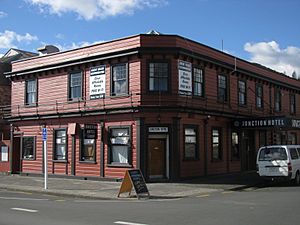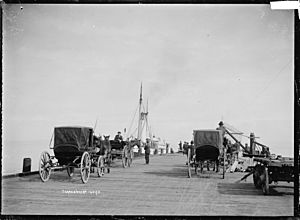Thames, New Zealand facts for kids
Quick facts for kids
Thames
Pārāwai (Māori)
|
|
|---|---|
| Country | New Zealand |
| Region | Waikato |
| District | Thames-Coromandel District |
| Ward | Thames Ward |
| Population
(June 2023)
|
|
| • Total | 7,630 |
| Postcode(s) |
3500, 3540
|
Thames (Māori: Pārāwai) is a town at the southwestern end of the Coromandel Peninsula in New Zealand's North Island. It is located on the Firth of Thames close to the mouth of the Waihou River. The town is the seat of the Thames-Coromandel District Council. The Māori iwi are Ngāti Maru, who are descendants of Marutuahu's son Te Ngako. Ngāti Maru is part of the Ngati Marutuahu confederation of tribes or better known as Hauraki Iwi.
Thames had an estimated population of 15,000 in 1870, but this declined to 4,500 in 1881, and it has increased modestly since. It is still the biggest town on the Coromandel. Until 2016, a historical oak tree that was planted by Governor George Grey stood on the corner of Grey and Rolleston streets.
Contents
History
Origin
Thames was formed from two historic towns, Grahamstown and Shortland, of which many original buildings still stand. Shortland was to the south of Thames and was founded on 27 July 1867 when James Mackay, civil commissioner for the Hauraki District, concluded an agreement with local Māori. The land was rented for mining purposes for the sum of £5,000 per year, a colossal sum in the mid 19th century. This agreement secured the rights to local mineral deposits leading to the proclamation of the Thames Goldfield on 1 August. The leasing of the land for such a huge income was a source of great envy by other Maori iwi and hapu.
Grahamstown was founded the following year at the northern end of present Thames, approximately one mile from Shortland. The two towns merged in 1874 after it emerged the heart of the Goldfield was in Grahamstown. Shortland waned in importance until the turn of the century when the Hauraki Plains were developed for farming and the Shortland railway station was opened.
Gold rush
The town was initially built during a gold rush, with the first major discovery of gold being made on 10 August 1867 by William Hunt, in the Kuranui Stream at the north end of Thames. The subsequent mine produced more than 102,353oz bullion and was known as the Shotover. The era from 1868 to 1871 were the bonanza years for the town with gold production topping one million pounds sterling at its peak. Official figures for production of the Thames Mines recorded a yield of 2,327,619oz bullion with the value at $845 million. The three richest fields were the Manukau / Golden Crown / Caledonian mines but many others yielded near equivalent amounts. Towards the end of the 19th century, Thames was the largest centre of population in New Zealand with 18,000 inhabitants and well over 100 hotels and three theatres in 1868. For a while, it was thought it would replace Auckland as the major town in the area. Thames also benefited from a period of extensive Kauri logging in the surrounding ranges around the same time.
Meeting house
The land involved in goldmining in Thames was Māori-owned; important parts of the goldfield were owned by the Ngāti Maru rangatira (chief) Rapana Maunganoa and the Taipari family. In 1878, when Wiremu Hōterene Taipari married a woman of the Ngāti Awa tribe of Whakatāne, Ngāti Awa carvers arrived at Thames and built a meeting house at Pārāwai. It is incorrectly said to have been a wedding gift for the couple when actually Wiremu's father had paid money for another whare (meeting house), which was sold to the governor general at the time. When Wiremu's father returned to collect the whare the Ngati Awa chief apologised and said he would have another one built which would signify the marriage between Wiremu Taipari and his daughter. The house, named Hotunui in honour of an important Ngāti Maru ancestor, now stands in the Auckland War Memorial Museum.
Recent history
The Thames branch railway connecting the town with Hamilton was opened in 1898 and was closed in 1991 and the tracks were taken up. It now provides part of the course for the Hauraki Rail Trail. The Carters - Kopu sawmill, 9 km south of Thames, closed in 2008 with the loss of 145 jobs. In 2012, mayor of Thames-Coromandel called NZTA safety procedures into question when a sink hole on State Highway 25 north of Thames, opened above an old mine shaft.
Economy
Thames Hospital is the oldest still operating in New Zealand, having been built in the 1860s. The Māori owned land was donated by the Ngāti Maru rangatira Rapana Maunganoa. A new clinical centre and other improvements were completed in 2008, and a new maternity facility opened on 5 September 2011. The Thames Jockey Club was one of the earliest to be established in New Zealand.
The Thames Aerodrome is 3 km south of the town. Regular flights to Auckland are operated by Great Barrier Airlines. A major employer is the Toyota New Zealand plant, which assembled CKD cars until 1998, and now refurbishes imported used cars. Another is the precision engineering works and foundry of A & G Price, established 1868, who built 123 steam locomotives for New Zealand Railways Department. The Brian Boru Hotel, built in 1868, is the oldest Irish pub in New Zealand. Goldfields Shopping Centre is a major shopping mall in Thames. Many residents work in tourism and locally owned businesses servicing the local farming community. Thames has also been used as a filming location for movies including Falling Inn Love and Bridge to Terabithia.
Retail
Most shops are located on Pollen Street.
The Goldfields Shopping Centre, located east of Pollen Street on the western side of the town centre, features about 15 shops including Pak'nSave, The Warehouse and Warehouse Stationery.
Demographics
| Historical population | ||
|---|---|---|
| Year | Pop. | ±% p.a. |
| 2006 | 6,930 | — |
| 2013 | 6,951 | +0.04% |
| 2018 | 7,293 | +0.97% |
Thames, comprising the statistical areas of Thames North, Thames Central, Thames South and Totora-Kopu, had a population of 7,293 at the 2018 New Zealand census, an increase of 342 people (4.9%) since the 2013 census, and an increase of 363 people (5.2%) since the 2006 census. There were 3,045 households. There were 3,420 males and 3,870 females, giving a sex ratio of 0.88 males per female, with 1,149 people (15.8%) aged under 15 years, 930 (12.8%) aged 15 to 29, 2,886 (39.6%) aged 30 to 64, and 2,337 (32.0%) aged 65 or older.
Ethnicities were 82.2% European/Pākehā, 22.1% Māori, 2.7% Pacific peoples, 6.3% Asian, and 1.8% other ethnicities (totals add to more than 100% since people could identify with multiple ethnicities).
The proportion of people born overseas was 16.7%, compared with 27.1% nationally.
Although some people objected to giving their religion, 47.9% had no religion, 38.1% were Christian, 1.0% were Hindu, 0.2% were Muslim, 1.5% were Buddhist and 3.6% had other religions.
Of those at least 15 years old, 825 (13.4%) people had a bachelor or higher degree, and 1,644 (26.8%) people had no formal qualifications. The employment status of those at least 15 was that 2,175 (35.4%) people were employed full-time, 873 (14.2%) were part-time, and 180 (2.9%) were unemployed.
Education
Thames High School is a secondary (years 9–13) school with a decile rating of 6 and a roll of 408. The school was established in 1880 and is the second oldest secondary school in the Auckland Province.
Moanataiari School, Parawai and Thames South are full primary (years 1–8) schools with decile ratings of 5, 6 and 3 and rolls of 149, 228 and 77, respectively.
St Francis School is a full primary (years 1–8) school with a decile rating of 7 and a roll of 75. It is a state integrated Catholic school.
All these schools are coeducational. Rolls are as of April 2023.
A former local institution of learning was the Thames School of Mines.
Another former school, Thames North, was at Tararu. It is now Thames Art Gallery.
Transport
Port
Initially the main access to Thames was by sea, with goods and passengers landed on the beach. Shortland Wharf was built in 1868 and remains in use. Thames Harbour Board controlled the port from 1876 until it was merged with the Town Council in 1936. By then competition, following the opening of the railway in 1898 and then the Hauraki (now Kopu) Bridge in 1928, had reduced the profitability of the wharves and a commissioner had been appointed, as the town couldn't meet its debts.
Ships which have served Thames have included SS Go Ahead and Northern Steamship Co's Terranora (1898), Kapui (1911) and Waipu (1928).
Railway
The Thames branch railway connecting the town with Hamilton was opened in 1898 and was closed in 1991 and the tracks were taken up, though Thames railway station remains. The branch now provides part of the course for the Hauraki Rail Trail.
Road
Thames is on SH25.
Bus
Thames Connector buses run 5 times a day between Tararu and Parawai. Go Kiwi operate a shuttle bus from the east coast of Coromandel, via Thames, to Auckland. InterCity run twice a day between Auckland and Tauranga via Thames.
Notable people from Thames
- Kylie Bax – model and actress
- Frances Haselden – headmistress of Kauaeranga Girls' School in Thames
- Sonny Parker – Welsh international rugby union player
- Lloyd Stephenson – hockey player
- Bruce Purchase – British actor
- Air Chief Marshal Sir Keith Park – WW2 Air Commander and AOC 11 Group during Battle of Britain (July – October 1940)
- Sir Graham Liggins - medical/obstetrical researcher
Images for kids





